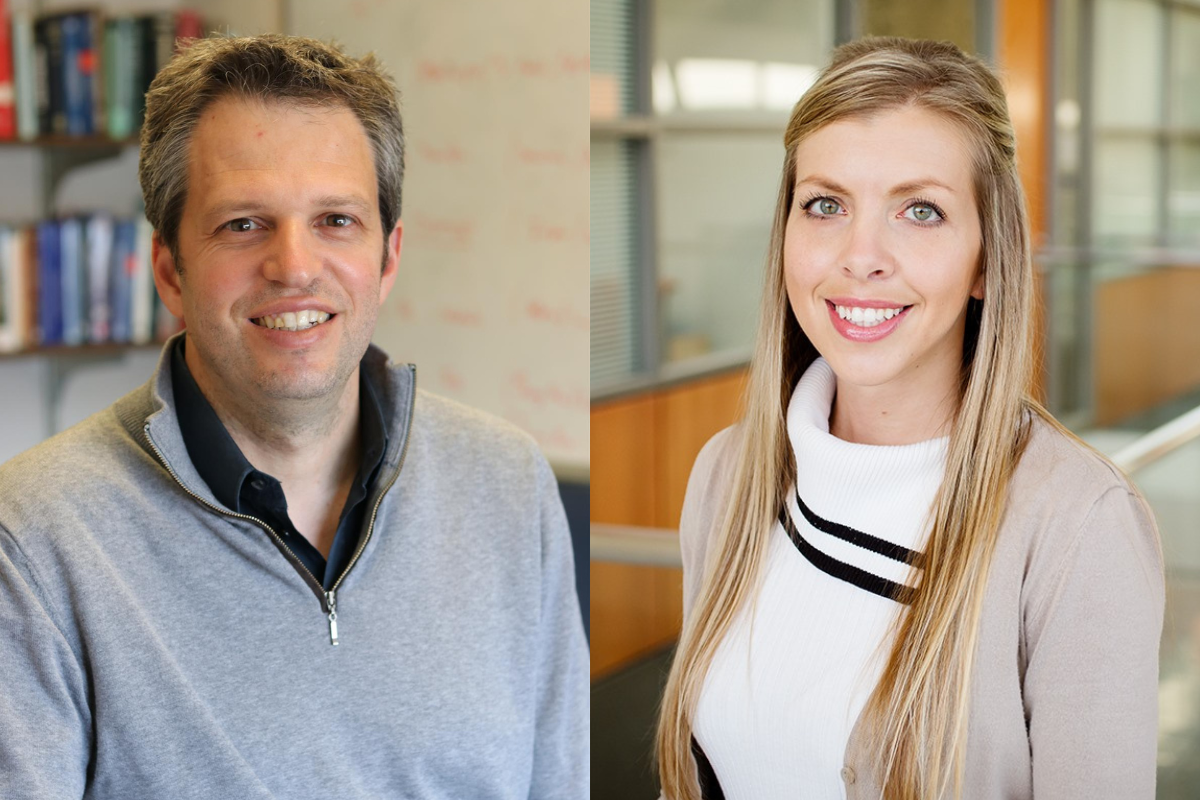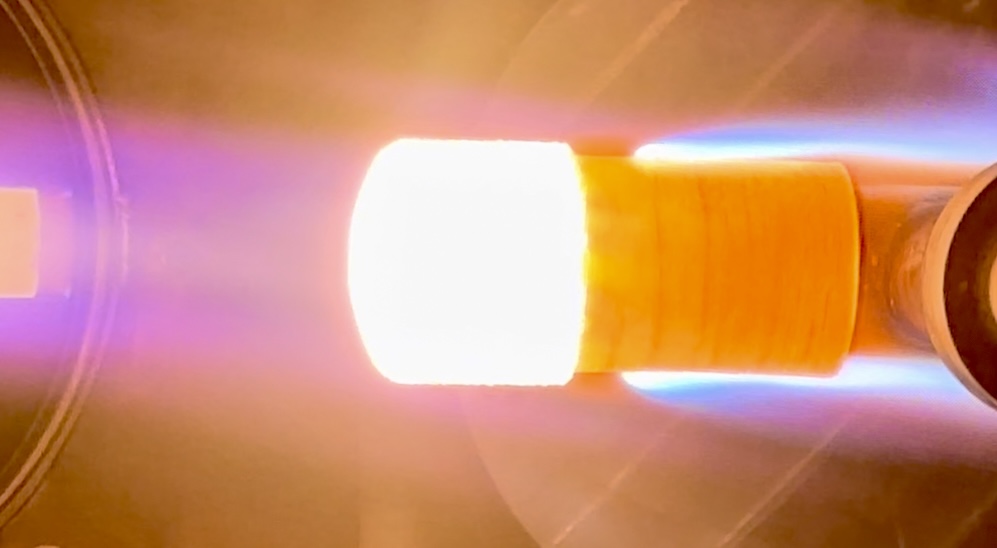Hypersonics Duo Marco Panesi and Kelly Stephani Bring Expertise to UC Irvine

Oct. 27, 2025 - Hypersonics experts Marco Panesi and Kelly Stephani have joined the UC Irvine Samueli School of Engineering, bringing with them globally recognized expertise in hypersonics, plasma physics and atmospheric entry systems. Hypersonics works with speeds of at least Mach 5 –five times the speed of sound. Their arrival marks an expansion of UCI’s leadership in aerospace research and technologies central to space exploration and national defense.
Panesi’s fascination with hypersonic flows began during his graduate studies at the Von Kármán Institute for Fluid Dynamics (VKI) in Belgium. “At VKI, I joined the plasma team, which focused on the extreme physics typical of hypersonic flows –that’s where I fell in love with it,” he recalls.
Stephani’s passion for engineering, aeronautics and space started at a young age, and took hold in her undergraduate and graduate studies, where her research focused on hypersonics. “I vividly recall the Space Shuttle Columbia accident, and in the years that followed, I had the opportunity to study under and work alongside some of the most talented and dedicated scientists and engineers in this field.”
Today, Panesi’s research probes the fundamental physics of high-speed flight and plasma-flow interactions, with a focus on modeling the chemical and radiative processes that govern gases at extreme temperatures. His work addresses one of aerospace science’s grand challenges: predicting and controlling hypersonic flow behavior.
Stephani leads a research team focused on thermophysical processes and material response in hypersonic thermal protection systems (TPS), including surface reactions and gas-surface interactions, transport, phase change and TPS performance including resilience and degradation.
Hypersonics and the challenge of planetary entry
Hypersonics is one of the most demanding frontiers in fluid dynamics – a regime that couples plasma physics, materials science and thermochemistry in one of nature’s most extreme environments. At speeds exceeding Mach 5, gas temperatures behind shock waves become so high that molecules dissociate and ionize, forming a plasma.
“During atmospheric entry, the gas temperature can exceed twice the surface temperature of the Sun,” Panesi explains. “To protect the vehicle, we design thermal protection systems that ablate – they burn and release gases that carry away heat.”
Understanding and predicting these coupled chemical–fluid–material processes, especially when ablation and surface chemistry are involved, remain among the most complex problems in spacecraft design. Panesi and Stephani have been addressing these challenges for decades through collaborations with NASA, Department of Defense (DOD), and European Space Agency (ESA).

From Illinois to Irvine: Building the next generation of hypersonics research
Before joining UCI, Panesi was a professor of aerospace engineering at the University of Illinois Urbana-Champaign, where he co-founded and directed the Center for Hypersonics and Entry Systems Studies (CHESS) with Stephani, who served as associate director. Under their leadership, CHESS became a national hub for interdisciplinary hypersonics research, featuring the largest inductively coupled plasma (ICP) wind tunnel in the United States.
While CHESS emphasized experimental infrastructure and materials testing, their new vision at UCI focuses on advanced computation – integrating applied mathematics, high-performance computing and uncertainty quantification into hypersonic science.
Panesi currently leads the flow physics activities within NASA’s Advanced Computational Center for Entry System Simulation, led by Professor Iain Boyd at University of Colorado Boulder. He also serves as a co-investigator in a Department of Defense MURI project on hypersonic turbulence-chemistry interactions. His contributions focus on modeling reacting kinetic processes in external hypersonic flows and gas-surface interactions.
Panesi’s group is also collaborating with SpaceX on the design of new thermal protection systems for Mars-entry vehicles, a project that unites academic modeling with industrial testing. “Working with SpaceX has been a fascinating experience,” Panesi notes. “Their approach to engineering is incredibly dynamic and results-driven. Collaborating with such talented, agile engineers has been life-changing. It’s a mutually beneficial partnership — our models simulate the harsh hypersonic environment and the ICP facility flows, while SpaceX conducts complementary testing at CHESS.”
At UCI, Panesi and Stephani are establishing the HERMES Group (Hypersonic Entry & Reentry Multiscale Experiments & Simulation), a new research hub that integrates advanced modeling, experimental data and computational science to enable the next generation of entry systems.
“Our goal at UCI is to extend the CHESS legacy into the UC system,” Panesi says. “We want to build a center of excellence that couples computation, materials and experimental science to address the full spectrum of hypersonic flight – from fundamental plasma physics to vehicle-scale design.”
Strengthening national defense technology
Panesi is also one of the few recipients nationwide of the prestigious Vannevar Bush Faculty Fellowship – the DOD’s premier award for single-investigator research. The fellowship supports high-risk, high-reward projects that explore bold, unconventional ideas.
Funded for five years with up to $3 million, the fellowship supports Panesi’s fundamental research into the physics of nonequilibrium plasmas. His proposal seeks to reformulate fluid mechanics by embedding Boltzmann-equation physics – which governs the dynamics of reacting and ionized gases – into a generalized, computationally efficient framework that transcends the classical Navier–Stokes equations.
“My goal is to generalize Navier–Stokes into something more universal,” he explains. “It should describe plasmas, chemically reacting gases and conventional aerodynamics alike. If successful, it could unify the modeling of nonequilibrium flows across aerospace, plasma physics and astrophysics.”
As a Vannevar Bush Faculty Fellow, Panesi also participates in the Bush Fellows Research Study Team (BFRST) — a program designed to provide direct engagement between leading academic researchers and DOD commands and leadership. Each year, BFRST fellows spend about two weeks visiting key DOD installations across the nation, including the Pentagon, where they engage with senior civilian and military leaders to better understand the Department’s missions, operational challenges and research priorities.
Through a strategic partnership with the Test Resource Management Center (TRMC) and the Hypersonic Science and Technology (HSST) enterprise, Panesi and Stephani – in collaboration with colleagues at CHESS – are advancing the next generation of ground-test and simulation infrastructure to meet the nation’s urgent need for high-fidelity hypersonic testing.
This initiative supports the development of multiple ICP facilities designed to replicate the extreme thermal and chemical environments experienced during atmospheric entry. The program includes the commissioning and characterization of Plasmatron One, Plasmatron X and the forthcoming Hypertron (currently in the design phase), which together will constitute the most advanced suite of hypersonic plasma testing capabilities in the United States.
These facilities provide the DOD and industry partners with unprecedented capability for TPS material testing, advanced diagnostics and validation of computational models, while serving as a national platform for training, uncertainty quantification and multiscale modeling of high-enthalpy flows.
The collaboration with TRMC and HSST thus establishes a critical bridge between experimental science, computation and engineering design, directly supporting the DOD mission to field the next generation of hypersonic flight systems and ensuring that UCI plays a leading role in shaping the nation’s hypersonics research infrastructure. Stephani adds that the aerospace private sector in Southern California is experiencing significant growth and is an ideal backdrop for research partnerships and workforce development with UCI.
"These appointments mark a major step in our department’s continued rise as a leading aerospace program,” said Julían Rimoli, chair of the UCI Department of Mechanical and Aerospace Engineering. “The addition of Professors Panesi and Stephani allows us to expand our historical strength in fluids, propulsion and combustion into the hypersonic regime – coupling plasma physics, materials science and high-fidelity computation to tackle some of aerospace engineering’s most demanding problems.”
Panesi and Stephani want to make UCI a national leader in hypersonics research. Their work supports national priorities in space exploration, planetary entry and defense technologies, while cultivating a vibrant research ecosystem for students and faculty alike. Panesi concludes, “By connecting computation, materials and experimentation, we can tackle the full hypersonic problem – from the quantum scale to the vehicle scale – and train the scientists who will carry this field forward.”
- Natalie Tso
